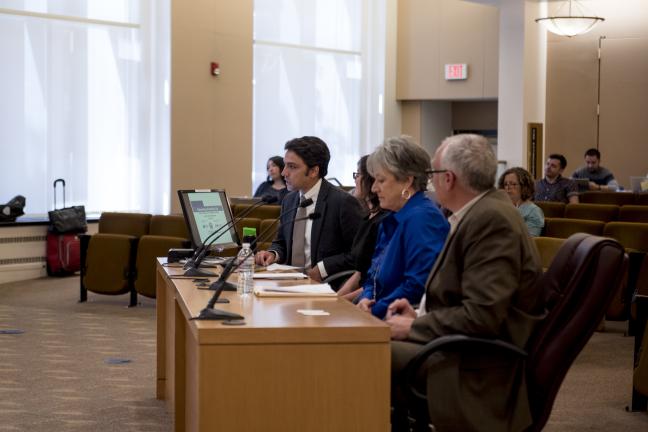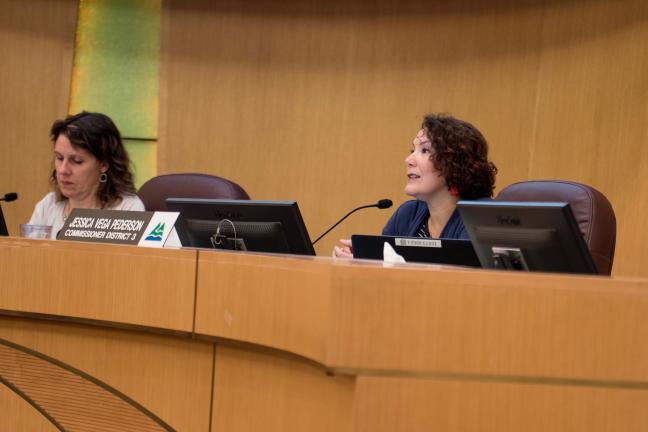Local governments should promote incentives to voluntarily replace dirty diesel engines and wood-burning fireplaces, researchers told the Multnomah County Board of Commissioners on Tuesday, June 26, as they presented findings of a report on ways local jurisdictions can reduce or prevent toxic air pollution.
The report is the result of two years of planning and research, said John Wasiutynski, director of the Office of Sustainability.
“County staff has worked with local jurisdictions to determine our options, and the practicality of those options, to help and address some of the serious health concerns that air pollution creates in our community,” Wasiutynski said. “Our consultant team has done extensive research to help us understand best practices and the feasibility of implementing those practices here in Multnomah County.”
The report recommends local governments:
- Develop a uniform approach to air quality monitoring.
- Build on existing woodsmoke regulations.
- Require newer model engines and engine retrofits on public construction projects.
- Develop a grant program to replace and retrofit old commercial engines that operate in the Metro area.
- Establish a non-road diesel engine registry similar to Vancouver B.C.’s Non-road Diesel Emission program.
Eugene-based Good Company and Massachusetts-based Eastern Research Group spent eight months meeting with local and state agencies, and identified projects in neighboring states that might be replicated here. The recommendations did not include creating a local air authority to impose tighter emission standards.
Regional air quality authorities were common in Oregon before the state established the Department of Environment Quality to oversee compliance with the federal Air Quality Act of 1967 and the Clean Air Act of 1970. The Portland region has remained in compliance with standards for the six air pollutants regulated by the U.S. Environmental Protection Agency under the 1970 law.
Yet 187 other toxins used by industry are not regulated under the federal law but are required to be reported to the state DEQ. The DEQ published a report in 2012, finding that residents in the Portland region were exposed to air toxics at levels which put them at risk for cancer. One source of emissions was smoke from wood-burning stoves. In 2014, a survey found residents in the Portland area burned about 80 percent more wood than previously estimated.
Meanwhile, between 2013 and 2016, the U.S. Forest Service examined Portland area moss samples and identified heavy metal hotspots. Those findings spurred a public demand for action. And in 2016 Gov. Kate Brown announced the Cleaner Air Oregon initiative, which would establish emission limits based on toxicity, in addition to the proximity of those emissions to people.
Officials with the City of Portland and Multnomah County said they would take action if the state initiative failed to curb emissions, raising the possibility of creating a regional air quality authority to regulate emissions and enforce tighter restrictions. Last year, they invested $120,000 to study their options.
Paula Fields Simms, an environmental engineer with ERG, said the research team then used EPA data to assess the risk air toxins posed to Portland-area residents. They found 53 people per million are exposed to cancer-causing levels of air toxics in the Tri-County area; higher than the national average of about 40 per million.
“That cancer risk doesn’t include exposure to diesel,” she said. “There’s not a factor in EPA data that allows that to be included. So these numbers are underreporting cancer risk. That could be significant.”
Chair Deborah Kafoury said despite the many briefings she’s attended on the region’s air quality, it’s still striking to compare the public’s perception of Portland with its reality.
“There’s a real disconnect between what we believe about ourselves as a green oasis with strong environmental laws and the reality that we have really dirty air,” she said. “I really don’t believe our community understands the level to which we have a real problem here in Portland and Multnomah County.”
Kafoury and other elected leaders had called for stronger air toxins oversight and a more robust enforcement of existing laws. She said she wanted the state to do a better job. If the state lawmakers wouldn’t act, she said, the county would consider doing so. Even if it meant taking that power away from the state DEQ and creating a local air authority. Researcher Josh Proudfoot with Good Company on Tuesday said the majority of the region’s risk from air pollution is concentrated in the City of Portland and Multnomah County, and a local authority would have more power to protect its own residents. That’s a power the state’s Department of Environmental Quality has but can’t employ.
“The DEQ doesn’t have funds to deliver what this community wants,” he said. “It’s not that the DEQ has a lack of interest. They’re just not financed to get to the level of quality that people are seeking.”
But establishing a regional authority would be complex and costly. Commissioner Jessica Vega Pederson worried that creating a regional air quality authority would take money away from an already cash-strapped DEQ. Industry that now pays for oversight from the DEQ would instead pay a local authority.
“I’m going to guess a significant amount [of the DEQ’s regulatory budget] comes from our region and I know that’s spread throughout the state,” she said. “It’s no question that we need to do more work on this, but it will be a big discussion about what we do.”
Proudfoot said quality air monitoring data would help cull public interest in tightening emissions. The county could also fund a position within the DEQ to help it recover from a backlog of industrial permitting. And officials might be surprised how willing industry would be to change with the support of conversion grants and technical assistance.
“Our recommendation is not to create a new regulatory authority,” he said. “It seems that the collaborative model is the best approach and it can be very effective. Voluntary efforts may sound like nothing is going to happen. But if operators are offered the opportunity to get better equipment that performs better, you will find success.”

